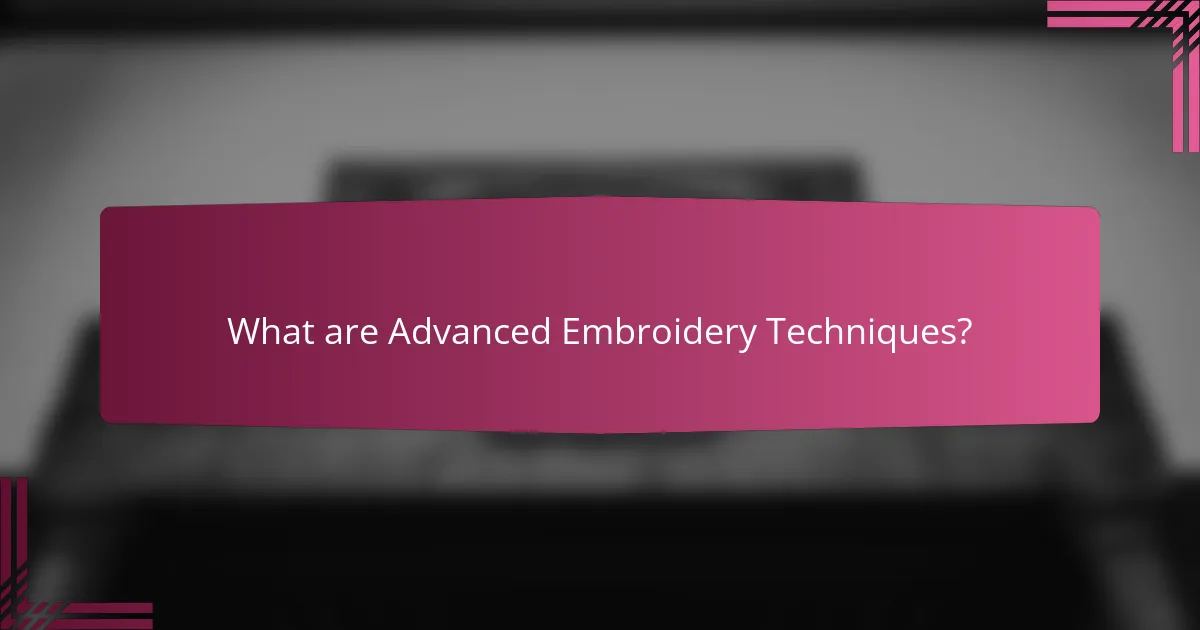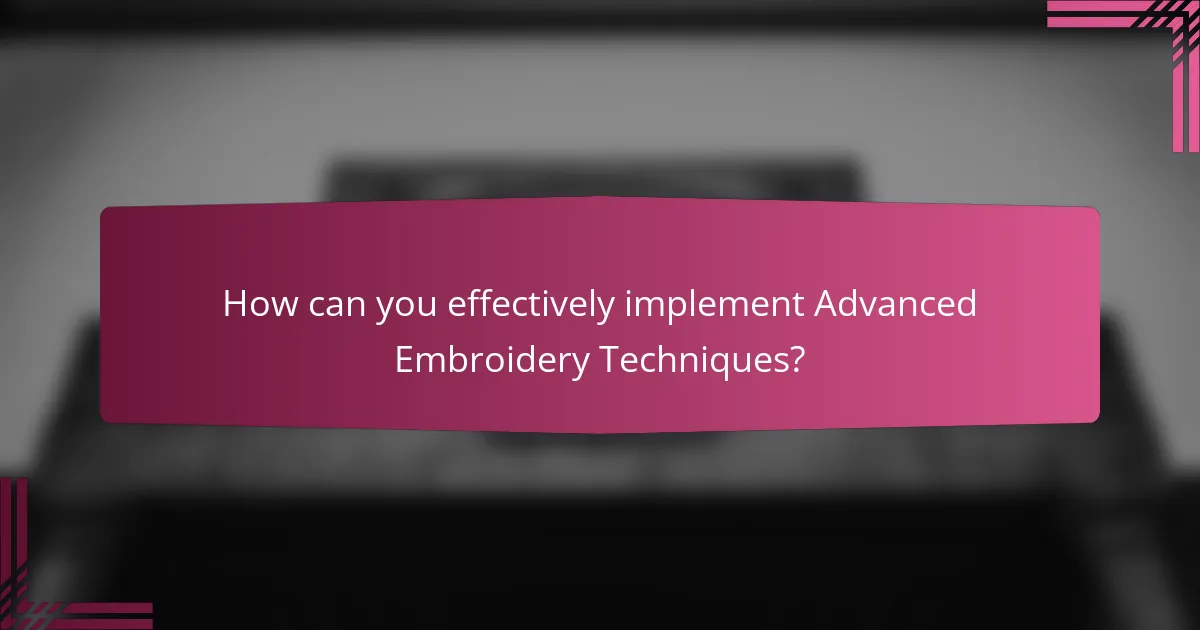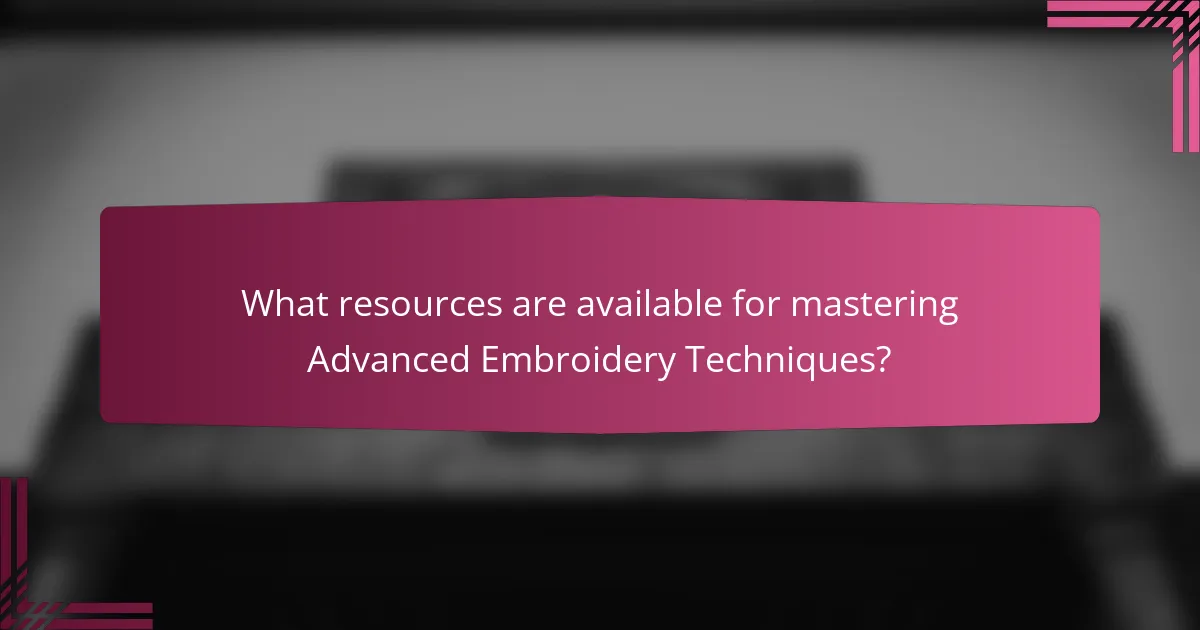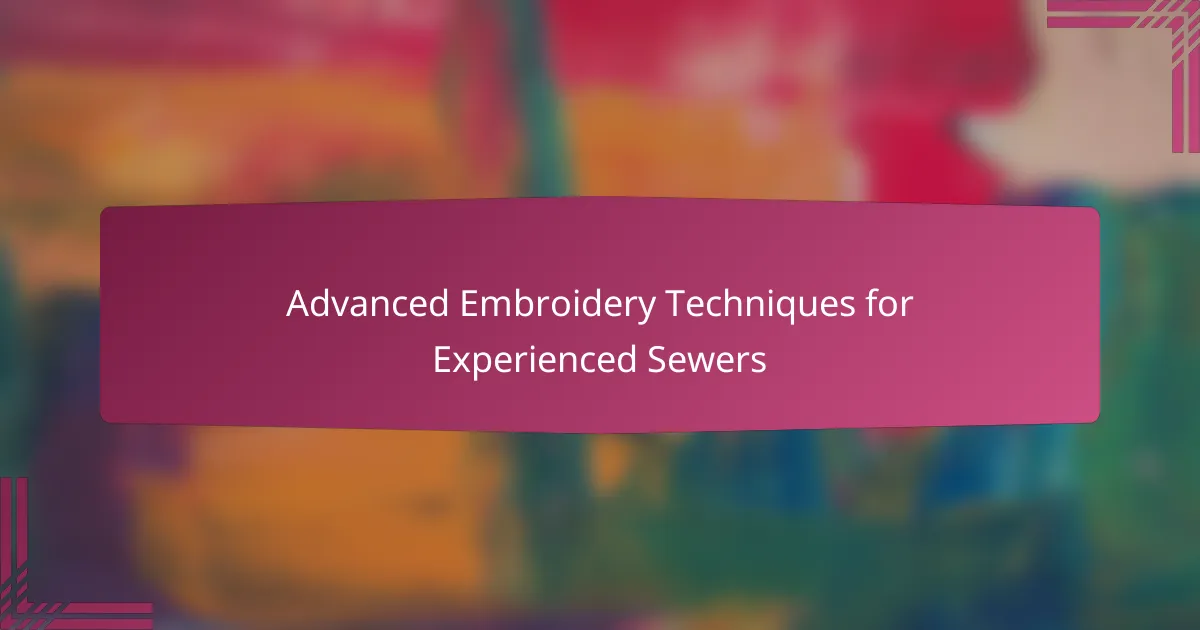
What are Advanced Embroidery Techniques?
Advanced embroidery techniques involve sophisticated methods used to enhance textile art. These techniques include machine embroidery, free-motion stitching, and thread painting. They allow for intricate designs and detailed patterns. Advanced techniques often utilize specialty threads and stabilizers. Techniques like appliqué and cutwork add dimension and texture. Many experienced sewers also explore digital embroidery methods. These methods integrate technology with traditional practices. Mastery of these techniques can elevate an embroidery project significantly.
How do Advanced Embroidery Techniques differ from Basic Techniques?
Advanced embroidery techniques involve more complex methods compared to basic techniques. Basic techniques focus on simple stitches and patterns. They often use straightforward tools and require minimal skill. Advanced techniques incorporate intricate designs and multiple layers. They utilize specialized tools and software for digital embroidery. Advanced techniques also allow for greater creativity and customization. This complexity requires a deeper understanding of fabric and thread types. Mastery of advanced techniques can enhance the overall quality and detail of the embroidery work.
What skills are essential for mastering Advanced Embroidery Techniques?
Essential skills for mastering advanced embroidery techniques include precision stitching, design interpretation, and fabric knowledge. Precision stitching is crucial for creating intricate patterns and ensuring high-quality results. Design interpretation allows sewers to visualize and execute complex designs accurately. Fabric knowledge is essential for selecting the right materials that complement specific techniques. Additionally, proficiency in using embroidery machines enhances efficiency and creativity. Understanding color theory aids in choosing harmonious color combinations. Familiarity with various embroidery styles expands creative possibilities. Mastery of these skills enables sewers to produce professional-level embroidery work.
Why is experience important in learning Advanced Embroidery Techniques?
Experience is important in learning Advanced Embroidery Techniques because it builds foundational skills. Experienced sewers have already developed basic sewing and embroidery abilities. This prior knowledge allows them to understand complex techniques more easily. They can also troubleshoot issues that arise during the embroidery process. Experience enhances creativity, enabling sewers to experiment with designs and materials. Moreover, familiarity with tools and machines leads to greater efficiency. Studies show that hands-on practice significantly improves skill retention. Therefore, experience directly contributes to mastering advanced embroidery techniques.
What types of Advanced Embroidery Techniques are available?
The types of advanced embroidery techniques available include machine embroidery, hand embroidery, and digital embroidery. Machine embroidery utilizes computerized sewing machines for precision and speed. Hand embroidery involves intricate stitching techniques done manually, offering a personalized touch. Digital embroidery integrates technology for design creation and execution, allowing for complex patterns. Other techniques include free-motion embroidery, which enables creative stitching without a fixed pattern, and appliqué, where fabric pieces are sewn onto a base fabric for decorative effects. Each technique provides unique artistic opportunities and can enhance the quality of embroidery projects.
How can different stitches enhance embroidery projects?
Different stitches can enhance embroidery projects by adding texture, depth, and visual interest. Each stitch type serves a unique purpose in design. For example, satin stitch creates a smooth, shiny finish. This is ideal for filling shapes and adding richness. Conversely, backstitch provides strong outlines and detail. It is effective for defining shapes and creating intricate designs.
French knots introduce dimension and can serve as decorative elements. They enhance the overall aesthetic by providing a tactile quality. Chain stitch offers a decorative edge and can be used in borders or to create flowing lines.
Utilizing a variety of stitches allows for creative expression. It can transform a simple design into a complex, multi-dimensional piece. Mixing stitches can also highlight specific areas, guiding the viewer’s eye. This technique is often used in advanced embroidery to achieve professional results.
What role do specialized tools play in Advanced Embroidery Techniques?
Specialized tools are essential in Advanced Embroidery Techniques. They enhance precision and efficiency in stitching. Tools like embroidery machines automate complex patterns. This reduces manual effort and time. Specialty hoops maintain fabric tension, ensuring even stitches. Scissors designed for embroidery provide clean cuts and prevent fraying. Additionally, software programs allow for intricate design customization. These tools collectively elevate the quality of finished projects. Their use is supported by industry standards, which emphasize the importance of precision in embroidery.
What are the benefits of using Advanced Embroidery Techniques?
Advanced embroidery techniques enhance the quality and creativity of textile designs. They allow for intricate patterns and detailed artwork that are difficult to achieve with basic methods. These techniques include 3D embroidery, which adds depth, and free-motion embroidery, which offers artistic freedom. Advanced methods also improve durability and longevity of the designs, reducing wear and tear. They often utilize specialized equipment that increases efficiency and precision. Furthermore, these techniques can elevate the perceived value of the final product, appealing to higher-end markets. Overall, advanced embroidery techniques contribute to both aesthetic appeal and functional advantages in textile projects.
How do Advanced Techniques improve the quality of finished projects?
Advanced techniques enhance the quality of finished projects by incorporating precision and creativity. These methods allow for intricate designs that elevate the overall aesthetic. Techniques such as digitizing improve accuracy in stitch placement. This results in cleaner lines and more defined patterns. Additionally, advanced materials can be utilized for better durability. Techniques like layering provide depth and texture that standard methods cannot achieve. The integration of technology also streamlines the process, reducing errors. Ultimately, these enhancements lead to a more professional and polished final product.
What creative opportunities do Advanced Embroidery Techniques provide?
Advanced embroidery techniques provide numerous creative opportunities for experienced sewers. These techniques allow for intricate designs that enhance the visual appeal of fabric. Techniques such as free-motion embroidery enable artists to create unique patterns and textures. Additionally, 3D embroidery adds depth, making designs stand out. Advanced techniques also facilitate the use of mixed media, combining embroidery with other crafts. This fusion can lead to innovative projects, such as embellished home decor or personalized gifts. Furthermore, these techniques can be applied to various materials, expanding the range of possible creations. Overall, advanced embroidery techniques empower sewers to explore their artistic expression in diverse and imaginative ways.

How can you effectively implement Advanced Embroidery Techniques?
To effectively implement advanced embroidery techniques, start by selecting high-quality materials. Use premium threads and fabrics to ensure durability and appearance. Next, familiarize yourself with complex stitch patterns. Techniques like satin stitch, French knots, and appliqué are essential for detailed designs. Invest in a reliable embroidery machine that offers advanced features. This includes multiple needle options and programmable patterns. Practice regularly to refine your skills and gain confidence. Additionally, study tutorials and attend workshops to learn from experts. Finally, experiment with combining techniques to create unique effects. These methods enhance your embroidery projects significantly.
What are the best practices for preparing your workspace?
To prepare your workspace effectively, ensure it is organized and free from clutter. A clean workspace enhances focus and efficiency. Arrange your tools and materials within easy reach. This minimizes distractions and saves time. Utilize proper lighting to reduce eye strain and improve visibility. Good lighting is essential for detailed embroidery work. Maintain a comfortable chair and desk height to promote good posture. Ergonomics can prevent fatigue during long sewing sessions. Regularly assess your workspace layout for functionality. Adjustments can significantly improve your workflow.
How should you organize materials for Advanced Embroidery projects?
Organize materials for Advanced Embroidery projects by categorizing them into specific groups. Group items by type, such as threads, fabrics, needles, and embellishments. Use clear containers or labeled bins for easy access. Keep frequently used tools in a designated area for convenience. Arrange threads by color or weight for quick selection during projects. Maintain a checklist of materials to ensure nothing is overlooked. Regularly review and restock supplies to stay prepared for new projects. This systematic approach enhances efficiency and creativity in advanced embroidery work.
What safety measures should you consider while working with embroidery tools?
When working with embroidery tools, consider wearing protective eyewear. This prevents injuries from flying debris or needle breaks. Additionally, use thimbles to protect your fingers while handling needles. Keeping your workspace organized reduces the risk of accidents. Always disconnect electrical tools when not in use to prevent shocks. Store sharp tools safely in designated areas to avoid cuts. Lastly, familiarize yourself with the tools’ manual for proper usage and safety guidelines. These measures are essential for a safe embroidery experience.
What common challenges do experienced sewers face with Advanced Techniques?
Experienced sewers face several common challenges with advanced techniques. One challenge is mastering the intricacies of machine settings. Incorrect tension and stitch length can lead to poor results. Another challenge is the complexity of design digitization. Converting artwork into stitch files requires specialized software skills. Experienced sewers also struggle with fabric selection for specific techniques. Some fabrics may not hold intricate designs well. Additionally, time management can be an issue when learning new techniques. Advanced methods often require more time to achieve desired outcomes. Lastly, troubleshooting errors in advanced projects can be daunting. Identifying and fixing issues can disrupt the workflow and create frustration.
How can you troubleshoot issues with thread tension?
To troubleshoot issues with thread tension, first check the thread type and needle compatibility. Ensure you are using the correct needle size for your thread. Next, examine the tension settings on your sewing machine. Adjust the upper thread tension if stitches are loose or too tight. Inspect the bobbin to ensure it is wound evenly and inserted correctly. Clean the machine to remove lint that may affect tension. Test stitch on scrap fabric to evaluate adjustments. Repeat adjustments as necessary until the desired tension is achieved.
What strategies can help prevent fabric puckering during embroidery?
To prevent fabric puckering during embroidery, use stabilizers, adjust tension, and select appropriate needles. Stabilizers provide support to the fabric, reducing movement. Choose a stabilizer that matches the fabric type for optimal results. Adjusting the thread tension can help prevent excess pull on the fabric. Use a needle suitable for the fabric weight and type to minimize damage. Additionally, hoop the fabric securely to maintain its position during stitching. These strategies collectively help in achieving smooth embroidery without puckering.

What resources are available for mastering Advanced Embroidery Techniques?
Books on advanced embroidery techniques are widely available. Notable titles include “The Embroidery Book” by Anne Butler and “Embroidery Techniques” by Janice Jones. Online courses from platforms like Craftsy and Skillshare offer structured learning. YouTube channels dedicated to embroidery provide free tutorials and tips. Local craft stores often host workshops for hands-on experience. Forums and online communities, such as Reddit and Facebook groups, allow for sharing knowledge and receiving feedback. Additionally, embroidery blogs often feature advanced techniques and project ideas. These resources collectively enhance skills in advanced embroidery techniques.
How can online tutorials enhance your skills in Advanced Embroidery?
Online tutorials can significantly enhance your skills in Advanced Embroidery by providing accessible, structured learning. They offer step-by-step guidance on complex techniques. Many tutorials include video demonstrations, which visually clarify intricate processes. This visual aid helps in understanding stitches and patterns more effectively. Online platforms often feature user feedback and community support. This interaction fosters a collaborative learning environment. Additionally, tutorials cover a wide range of styles and techniques. This diversity allows you to explore new methods and expand your creative repertoire. Many tutorials are updated regularly to reflect current trends and technologies in embroidery. This ensures that your skills remain relevant and up-to-date.
What are the benefits of joining embroidery communities or forums?
Joining embroidery communities or forums provides valuable networking opportunities. Members can share techniques and tips that enhance skills. Access to diverse perspectives fosters creativity and innovation. These platforms offer support for troubleshooting and problem-solving. Members can participate in group challenges to improve their craft. Communities often share resources like patterns and tutorials. Engaging with others can lead to collaboration on projects. Overall, these communities create a sense of belonging among embroidery enthusiasts.
What tips can improve your proficiency in Advanced Embroidery Techniques?
Practice consistently to improve proficiency in Advanced Embroidery Techniques. Regular practice helps develop muscle memory and fine-tunes skills. Experiment with different stitches and materials to broaden your expertise. Attend workshops or online courses for guided instruction and feedback. Utilize high-quality tools and threads to enhance the final output. Study advanced techniques through books or online tutorials for in-depth understanding. Join embroidery communities for support and sharing experiences. Analyze your work critically to identify areas for improvement and adjust accordingly.
How can practicing with different fabrics enhance your technique?
Practicing with different fabrics enhances your technique by allowing you to adapt to various textures and weights. Each fabric behaves differently under a needle, affecting stitch quality and tension. For example, silk requires a lighter touch compared to denim, which is more robust. By experimenting with fabrics, you learn to adjust your stitch settings accordingly. This practice fosters greater control and precision in your embroidery work. Additionally, understanding how different fabrics react to heat and thread tension improves overall craftsmanship. Mastery of diverse materials leads to more creative and versatile projects.
What are some recommended projects for honing your Advanced Embroidery skills?
Recommended projects for honing Advanced Embroidery skills include creating intricate wall hangings. These projects allow for detailed designs and layering techniques. Another suggestion is to work on personalized clothing items, such as embroidered jackets or shirts. This involves combining embroidery with garment construction. Additionally, crafting decorative pillows can enhance skills in pattern placement and color blending. Finally, consider making custom quilts that incorporate various embroidery methods. Each of these projects challenges and develops advanced techniques in embroidery.
Advanced Embroidery Techniques encompass sophisticated methods that enhance textile art, including machine embroidery, free-motion stitching, and thread painting. This article outlines the differences between advanced and basic techniques, essential skills for mastery, and the variety of advanced methods available, such as 3D and digital embroidery. It also discusses the role of specialized tools, benefits of these techniques, and common challenges faced by experienced sewers. Additionally, the article provides resources for further learning and tips for improving proficiency in advanced embroidery.
